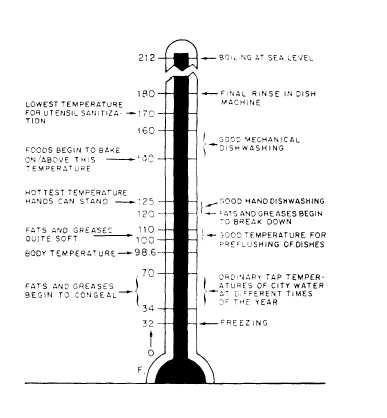| |
c Cans in unsatisfactory or surveyable condition
. Food products with spoilage or damage indicated
by offensive odors, presence of slime, abnormal color,
or other evidence of deterioration
. Food items adulterated by easily recognizable
foreign material such as metal, glass, dirt, or insects
Do not attempt to taste or cook food in these states.
It is safe to observe the old saying, “When in doubt,
throw it out.” ‘The risk of food-borne illness must be
avoided. After any occurrences of spoiled or damaged
food, corrective actions must be provided and measures
must be designed to prevent future occurrences.
KEEPING UTENSILS AND EQUIPMENT
CLEAN
All phases of sanitation in a general mess are
important. However, one of the most important is the
proper cleaning and sanitizing of equipment (including
trays, dishes, and other dinnerware) used for preparing,
handling, cooking, and serving food.
Dishes may be washed by hand or by machine.
Whatever the method, the final results may either be
excellent or poor, depending upon how conscientiously
you apply your knowledge and skill in using the
equipment and materials provided. The best equipment
and detergents will not do a good job of dishwashing if
used improperly.
Types of Soil
Unless the galley equipment and utensils are
thoroughly cleansed, food particles in which bacteria
may grow will remain on them. These food soils are
divided into several distinct types:
Freshly deposited soil —the soil that remains
immediately after the equipment or utensil has been used.
Thin film-—the soil that remains as the result of
ineffective cleaning, following a flushing with water.
Thin films are not easily seen and they are capable of
sustaining germs.
Built-up deposits—the result of repeated ineffective
cleaning methods causing a day-by-day accumulation
of soil.
Dried deposits—accumulations that result from
drying action and formation of a heavy crusty deposit.
Baked deposits—deposits that have been baked
onto equipment and have become difficult to remove.
Removing Stubborn Soils
The Navy procures the correct type of detergent to
be used in washing food preparation utensils and
equipment. Hot water also provides temperatures that
increase the chemical activities of the various
ingredients in properly compounded detergents.
Friction is an important part of cleaning. The required
friction may be applied by brushing with approved
brushes or by strong flushing, as in dishwashing
machines. A hard abrasive should never be used on any
metal surface. This results in scratches that provide
lodging places for soil. It is recommended that pots and
pans, cooking utensils, and other such items be
presoaked to loosen any food clinging to the utensil.
Then, they should be washed using the proper detergent
compound and hot water. A detergent increases the
effectiveness of the water as a cleaning agent. The
washed pots and pans must be rinsed with warm water
at 120°F to 140°F, then sanitized for 30 seconds in hot
water of 170°F or for at least 1 minute in an approved
chemical sanitizing solution such as the standard stock
chlorine-iodine type. Once washed and sanitized, the
clean pots and pans should be stored, bottoms up, in
clean racks. Otherwise, the effort spent in washing and
sanitizing them is wasted. Figure 1-6 shows the
Figure 1-6.—Temperatures necessary for proper sanitizing of
foodservice equipments and utensils.
1-12
|

